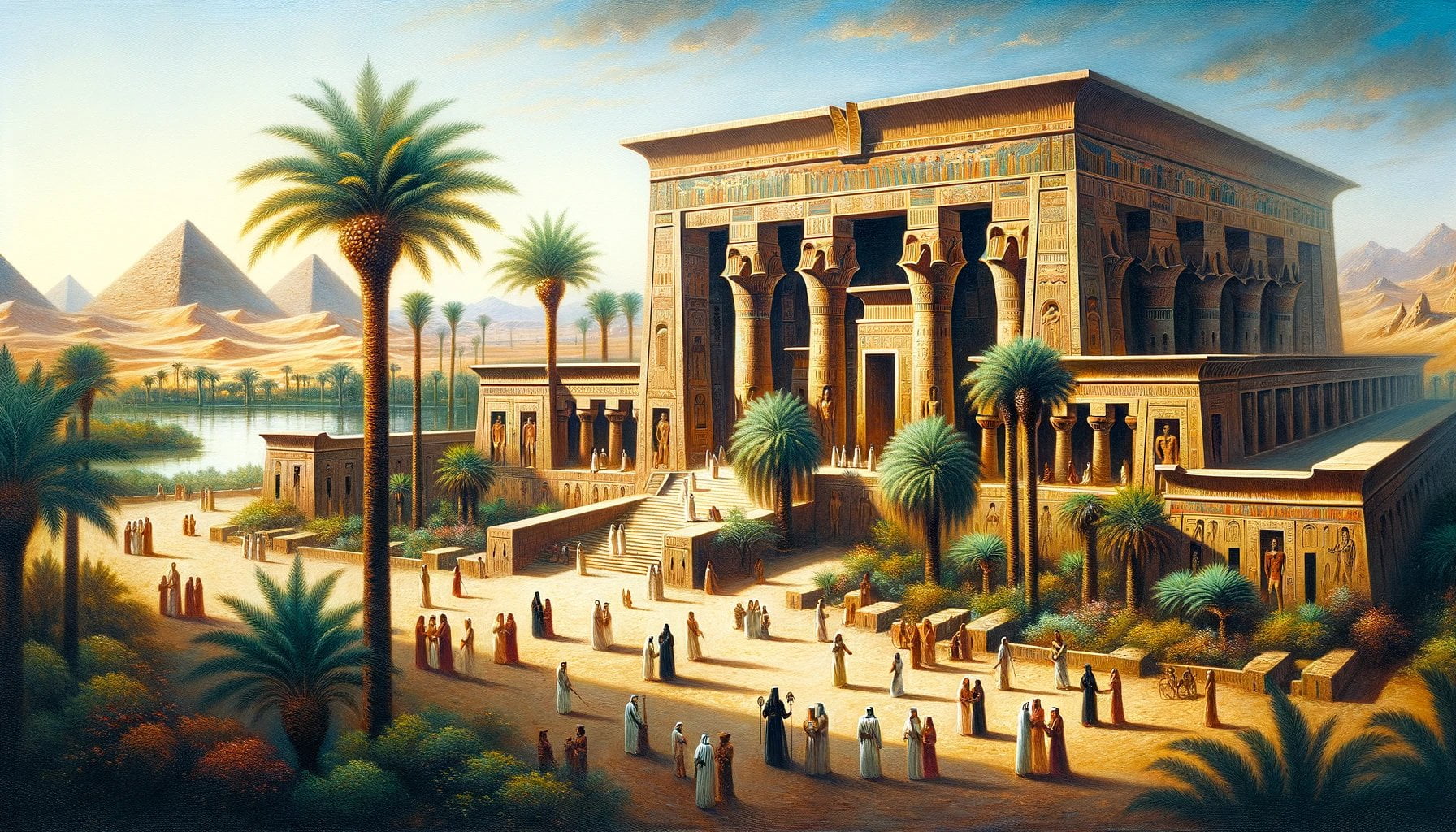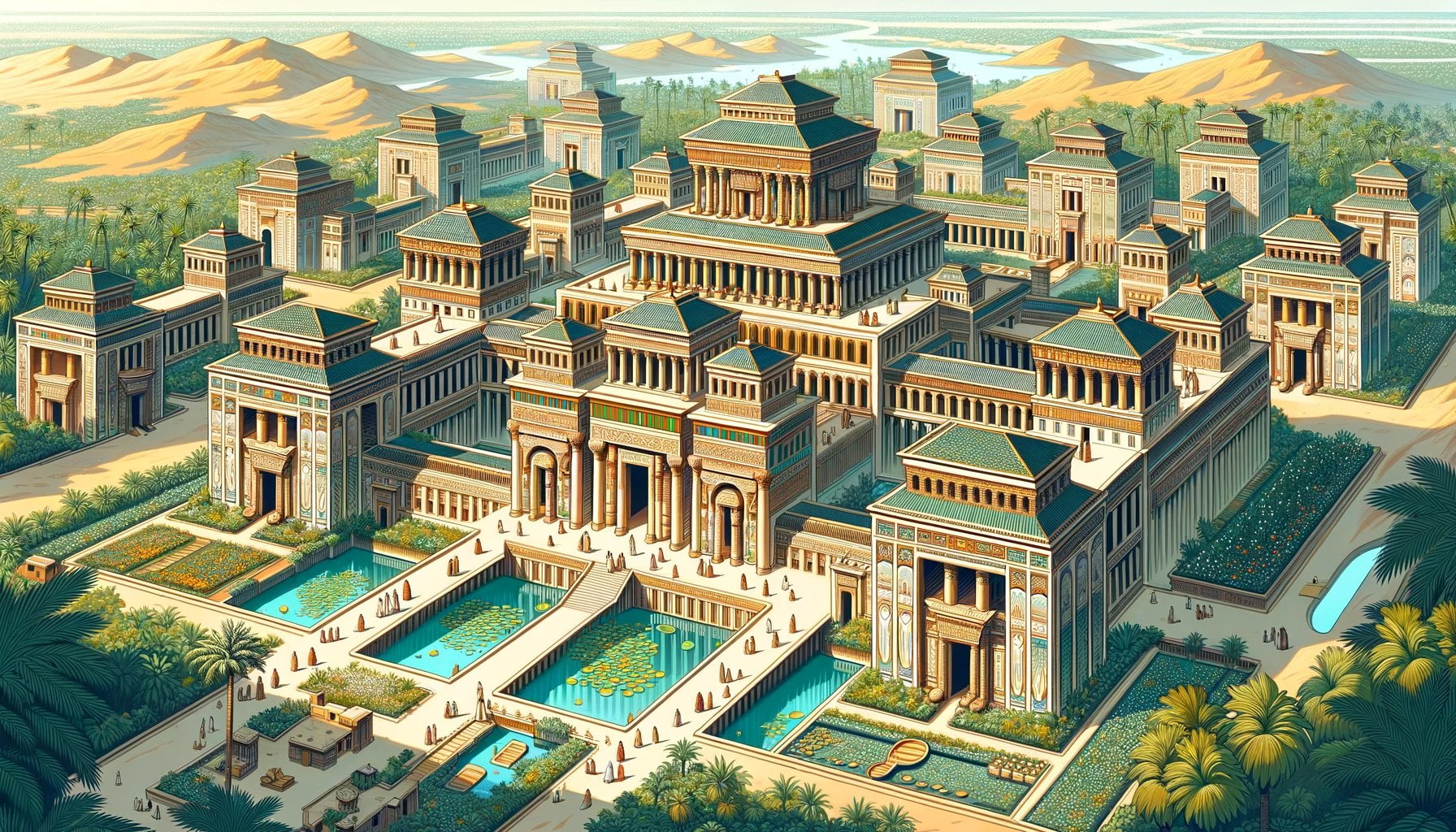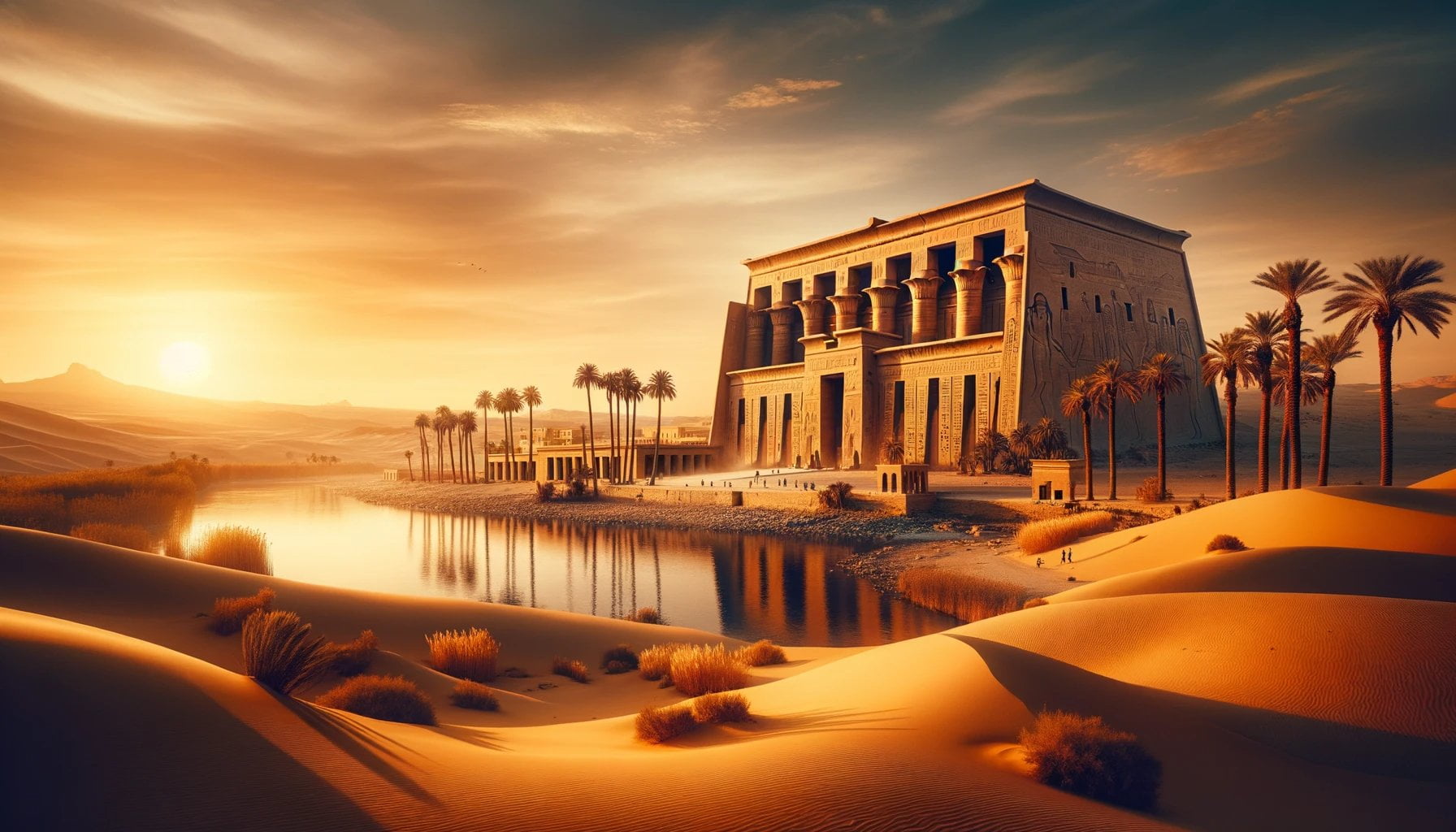Welcome to “Unveiling the Mysteries: Ancient Egyptian Palaces and Their Majestic Rulers.” In this article, we will delve into the captivating world of palaces in ancient Egypt, exploring their stunning architecture, intricate decorations, and the symbolic significance they held. With the expertise of an experienced archaeologist specializing in ancient civilizations, we aim to bring these opulent structures to life, shedding light on the fascinating lives of the pharaohs who once resided within these grand palaces. So join us on this journey as we unravel the secrets of ancient Egypt and its majestic rulers.

Key Takeaways:
– Ancient Egyptian palaces were important residences for pharaohs and their entourage, serving as headquarters of power and housing temples for worship.
– Palaces were divided into sections for the pharaoh and administration.
– Examples of ancient Egyptian palaces include the Ballas palace from the 16th century BC, the Ptolemaic palace in Silsila district from the 2nd century BC, the Roman palace in El Haiz area from 100 AD, and the Ahmad ibn Tulun Palace in Old Cairo from 870 AD.
– Palaces accommodated the mobile nature of pharaohs and their movements throughout Egypt.
– The Malkata palace complex built by Amenhotep III is one of the most extensive palace complexes known from ancient Egypt.
– Further information on ancient Egyptian palaces can be found in sources such as “Palaces in Ancient Egypt: Cities for Kings and Gods” by Brewminate and “List of Palaces in Egypt” on Wikipedia.
Palaces in Ancient Egypt
Palaces in ancient Egypt were not mere buildings; they were majestic and awe-inspiring structures that served as the residences of pharaohs and their entourage. These palaces were architectural marvels, intricately designed and adorned with ornate decorations. Today, let us embark on a journey to uncover the mysteries of palaces in ancient Egypt and explore the grandeur of the pharaohs who once dwelled within these opulent structures.
The Residences of Power
Palaces played a significant role in ancient Egypt as the headquarters of power. They were more than just homes for the pharaohs; they were symbols of authority and a testament to the greatness of their rulers. These palaces were divided into two main sections: one for the pharaoh and the other for administration, allowing for efficient governance of the vast Egyptian empire.
Examples of Ancient Egyptian Palaces
Let us delve into the rich history of palaces in ancient Egypt by exploring some notable examples:
- Ballas Palace (16th century BC): This magnificent palace, built by an unknown king, captivates us with its timeless beauty. Although its purpose remains shrouded in mystery, the remnants of this palace take us back to a bygone era.
- Ptolemaic Palace in Alexandria (2nd century BC): Situated in what is now Silsila district, this palace is a testament to the influence of the Ptolemaic dynasty. Its architectural splendor reflects the fusion of Egyptian and Greek styles.
- Roman Palace in El Haiz (100 AD): Located in the Bahariya Oasis, this palace showcases the Roman influence on ancient Egypt. It stands as a testament to the ever-evolving nature of Egyptian culture and architecture.
- Ahmad ibn Tulun Palace in Old Cairo (870 AD): Constructed during the Tulunid dynasty, this palace exemplifies the architectural prowess of the time. Its intricate design and historical significance make it a remarkable relic of ancient Egypt.
- Bulaq Palace of Ismail Pasha (19th century): Although more recent in comparison, this palace showcases the continuation of grandeur and opulence throughout Egyptian history. Built by Ismail Pasha in Giza, it stands as a reminder of Egypt’s rich heritage.
Beyond Residences
Palaces in ancient Egypt served various functions beyond being residences. The pharaohs were mobile rulers who traveled throughout Egypt, and these palaces accommodated their movements. Moreover, the palaces were not limited to physical structures; they extended into the realm of visual art. Ancient Egyptian tomb scenes depict the rewarding of tomb owners by the king at a ‘Window of Appearance,’ further illustrating the significance of these palaces in the culture and belief systems of the time.
Malkata Palace Complex
One of the most extensive palace complexes known from ancient Egypt is the Malkata palace complex built by Amenhotep III. Although now reduced to spoil-mounds, the remains of mud-brick buildings hint at the grandeur that once graced this magnificent site. Unearthing the secrets of the Malkata palace complex provides invaluable insights into the lifestyles and rituals of the pharaohs.
Exploring Further
To delve deeper into the world of palaces in ancient Egypt, additional resources can offer a wealth of information. Two noteworthy sources include:
- “Palaces in Ancient Egypt: Cities for Kings and Gods” by Brewminate – Source
- “List of Palaces in Egypt” on Wikipedia – Source
These sources provide further information on the significance and architectural aspects of ancient Egyptian palaces. Immerse yourself in the wonders of the past and embark on a journey through time as you explore the mysteries of palaces in ancient Egypt.
Here are some captivating sentences with active internal links:
- Did you know that the Battle of Actium was the largest naval battle in ancient history? Check out more about it here!
- Looking for fascinating ancient dog epitaphs? Look no further, we have a collection of them here!
- Explore the mysteries of an ancient city in Peru and discover its rich history here!
- Dive into the remarkable stories of ancient Vietnamese warriors and their incredible feats here!
- Curious about the intriguing names of ancient Egyptian queens? Uncover their secrets here!
- Discover the mesmerizing ancient Syrian names that are steeped in history here!
- Discover the hidden stories behind ancient queen names that ruled with power and grace here!
- Uncover the ingenious ancient Persian inventions that revolutionized history here!
- Embark on a journey through time and explore the remarkable achievements of ancient Romans here!
- Delve into the wonders of ancient castles in Africa and marvel at their grandeur here!
- Step into the mythical world of ancient Greek castles and immerse yourself in their legendary tales here!
- Immerse yourself in the rich history of an ancient Italian city that has stood the test of time here!
Remember to click on the links to explore these fascinating topics!
3. Significance of Palaces in Ancient Egyptian Society
Ancient Egyptian palaces hold immense historical and cultural significance, providing a glimpse into the lives of pharaohs and their noble entourage. These majestic structures played a crucial role in shaping ancient Egyptian society, symbolizing power, authority, and the grandeur of their rulers. Let’s explore the significance of palaces in ancient Egyptian society and delve into their fascinating world.
Palaces as Centers of Power and Authority
In ancient Egypt, palaces were more than just lavish residences. They were architectural marvels, designed to showcase the might and influence of the pharaohs. These palaces served as centers of power and authority, with the ruling pharaoh utilizing them to conduct important affairs of state and governance. From the vibrant courts to the elegant halls, every corner of the palace exuded majesty, reinforcing the pharaoh’s stature as a divine and all-powerful ruler.
Palaces as Symbolic Representations
Ancient Egyptian society placed significant importance on symbolism, and palaces were no exception. These awe-inspiring structures represented the pharaoh’s divine connection, embodying the concept of Ma’at – the harmony and order that governed the cosmos. The meticulously crafted architecture, adorned with intricate carvings, hieroglyphics, and vibrant paintings, conveyed the pharaoh’s divine lineage and their close association with the gods.
Cultural and Religious Significance
Palaces were not merely opulent residences; they were also cultural and religious centers. Within the palace walls, rituals, ceremonies, and festivals were conducted to honor the gods and maintain cosmic balance. These magnificent structures were often equipped with temples and shrines, allowing the pharaohs to fulfill their religious duties and embody their role as intermediaries between the mortal realm and the divine.
Economic Importance
Palaces played a vital role in the ancient Egyptian economy. They served as patrons of the arts, supporting artisans, craftsmen, and laborers who worked tirelessly to create intricate masterpieces. The construction and maintenance of palaces provided employment opportunities and stimulated economic growth within the surrounding areas. Moreover, the luxurious lifestyle of the pharaohs and their entourage necessitated a sophisticated system of agriculture, trade, and taxation to sustain their opulence.
Key Takeaways:
- Ancient Egyptian palaces were more than just residences; they represented power, authority, and the might of pharaohs.
- Palaces symbolized the divine connection of pharaohs and their association with the gods, showcasing their divine lineage.
- These magnificent structures served as religious and cultural centers, hosting rituals and ceremonies to honor the gods and maintain cosmic harmony.
- Palaces played a crucial role in the economy, supporting artisans, craftsmen, and laborers while stimulating economic growth in surrounding areas.
Sources:
– Britannica: Egyptian Architecture
– Ancient Egyptian Facts: Ancient Egyptian Palaces
4. Notable Palaces and Their Historical Importance
Palaces in ancient Egypt were not just extravagant residences; they were symbols of power and centers of authority. These opulent structures showcased the grandeur of the pharaohs and served as cultural, religious, and economic hubs of the ancient Egyptian civilization.
Valley of the Kings
– The Valley of the Kings, also known as the Valley of the Gates of the Kings, is a renowned site in ancient Egypt.
– Located on the west bank of the Nile River, it houses the tombs of pharaohs and powerful nobles from the New Kingdom period.
– The Valley of the Kings is famous for its magnificent tombs, including the iconic tomb of Tutankhamun.
Giza
– Giza is home to the iconic pyramids, including the Great Pyramid of Khufu, the largest pyramid in Egypt.
– These pyramids were built as tombs for the pharaohs and serve as a testament to the advanced architectural skills of ancient Egyptians.
Saqqara
– Saqqara is the ancient necropolis of the city of Memphis, the capital of ancient Egypt.
– It is known for the Step Pyramid of Djoser, which is considered the earliest large-scale stone construction and the oldest pyramid in Egypt.
Luxor Temple
– Located on the east bank of the Nile River in Luxor, the Luxor Temple was dedicated to the king of the gods, Amun-Ra.
– This temple showcases impressive architecture and was an essential religious center in ancient Egypt.
Abu Simbel
– Abu Simbel is an archaeological site housing two temples built by Ramesses II.
– These temples were relocated in the 1960s to protect them from flooding caused by the construction of the Aswan High Dam.
Karnak Temple Complex
– Situated in the ancient city of Thebes, the Karnak Temple Complex is one of the largest religious complexes globally.
– It consists of multiple temples and sanctuaries dedicated to various gods and pharaohs.
Temple of Hatshepsut
– The Temple of Hatshepsut is a mortuary temple located on the west bank of the Nile, near Luxor.
– It was built for the female pharaoh Hatshepsut and is renowned for its impressive architecture and beautiful reliefs.
These are just a few notable examples of the palaces and ancient sites in Egypt that highlight the historical importance of this era. They provide invaluable insights into the power, grandeur, and architectural achievements of the ancient Egyptian civilization.
Key Takeaways:
– Ancient Egyptian palaces, such as the ones mentioned above, served as symbols of power and authority for the pharaohs.
– These palaces were not only impressive residences but also cultural, religious, and economic centers.
– The Valley of the Kings, Giza, Saqqara, Luxor Temple, Abu Simbel, Karnak Temple Complex, and the Temple of Hatshepsut are notable examples of ancient Egyptian palaces and historic sites.
– Each palace and site offers unique architectural features and insights into the grandeur and lifestyles of the pharaohs who once resided there.
– Exploring these ancient sites provides a glimpse into the rich history, culture, and achievements of ancient Egypt.
Sources:
– Palaces in Ancient Egypt: Cities for Kings and Gods
– The 10 Best Historic Sites in Egypt | Historical Landmarks | History Hit
Exploration and Excavation of Ancient Egyptian Palaces
The Fascinating World of Ancient Egyptian Palaces Unveiled
Ancient Egyptian palaces stand as testaments to the grandeur and opulence of the pharaohs who once ruled over this majestic civilization. Through exploration and excavation, archaeologists have uncovered the mysteries hidden within these breathtaking structures, shedding light on the lives of ancient Egyptian rulers and their connection to the divine.
Breathtaking Structures: Unveiling the Treasures
Exploring ancient Egyptian palaces is a journey that takes us back in time to a world filled with wonder and beauty. These magnificent structures, such as the palace complex of Malkata built by Amenhotep III, were not only residences for the pharaohs but also served as sacred spaces for the gods. Covered in complex visual programs executed in paint on plaster, the walls, floors, and ceilings of these palaces created visually pleasing spaces fit for a king.
Decoding the Symbols: Insights from Excavations
Excavations and explorations in ancient Egyptian palaces have yielded valuable insights into their history, architecture, and significance. Through the deciphering of hieroglyphics and analysis of artifacts, archaeologists have been able to unravel the symbolic significance of various elements within these palaces. For example, the serekh, a device used to write the name of the king, and the cartouche, a device used to encircle royal names, provide glimpses into the pharaoh’s power and authority.
Centers of Power: Palaces as Administrative Hubs
Palaces in ancient Egypt were more than just residences for the pharaohs. Due to the mobility of the pharaohs and their active rule throughout Egypt, these palaces became significant centers of administration and governance. They played a vital role in the administration of the kingdom and the coordination of various activities across the land. Excavations have provided valuable information about the layout and organization of these administrative hubs, giving us a glimpse into the governance practices of ancient Egypt.
A Platform for Experts: The Conference on Palaces in Ancient Egypt
The significance of ancient Egyptian palaces was recognized through The Conference on Palaces in Ancient Egypt, held in London in 2013. Organized by the Austrian Science Fund, the Egypt Exploration Society, and the University of Würzburg, this conference brought together experts to discuss and share their research on these important structures. The conference served as a platform to dive deeper into the history, architecture, and cultural significance of palaces in ancient Egypt.
Key Takeaways:
- Ancient Egyptian palaces served as both residences for pharaohs and sacred spaces for gods.
- The intricate visual programs executed in these palaces showcased the wealth and power of the pharaohs.
- Excavations have provided valuable insights into the symbolic significance of features such as the serekh and the cartouche.
- Palaces served as administrative centers, playing a crucial role in the governance and coordination of activities throughout Egypt.
- The Conference on Palaces in Ancient Egypt brought together experts to discuss the significance and research of these structures.

FAQ
Q1: What is the significance of palaces in ancient Egypt?
A1: Palaces in ancient Egypt served as residences for kings and centers of power for both kings and gods. They showcased the authority and wealth of the ruling class and played a crucial role in ancient Egyptian society.
Q2: Can you provide examples of notable palaces in ancient Egypt?
A2: Some notable palaces in ancient Egypt include the palace complex of Malkata, built by Amenhotep III, and the Valley of the Kings, which houses the tombs of pharaohs and powerful nobles from the New Kingdom period.
Q3: Were ancient Egyptian palaces solely used as residences?
A3: No, ancient Egyptian palaces were not just simple residences. They were also elite theaters of power, with the objects inside them serving as visible signs of power. These palaces and temples were important in showcasing the authority and wealth of the ruling class.
Q4: What is the architectural significance of ancient Egyptian palaces?
A4: The walls, floors, and ceilings of Egyptian royal palaces were often covered in complex visual programs executed in paint on plaster, creating visually pleasing spaces for the king. These architectural features provide insights into the artistic and religious practices of ancient Egypt.
Q5: Did excavations provide valuable information about ancient Egyptian palaces?
A5: Yes, excavations and explorations in ancient Egyptian palaces have yielded valuable insights into the history and architecture of these structures. They have helped researchers understand the form, function, and significance of palaces in ancient Egyptian society.










